Political Response Tracker #4
art and politics bay area blog CA TPG8
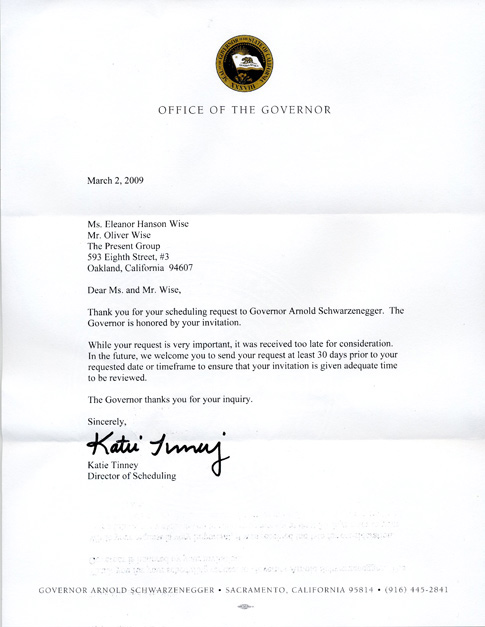
bay area blog CA events others lives personal pictures
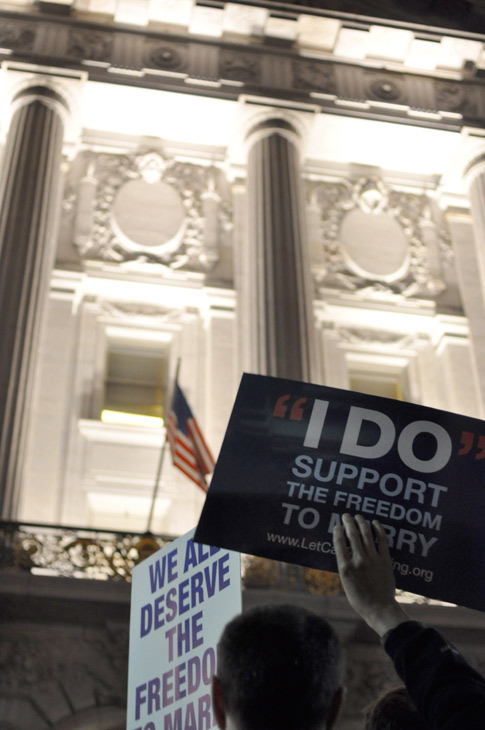
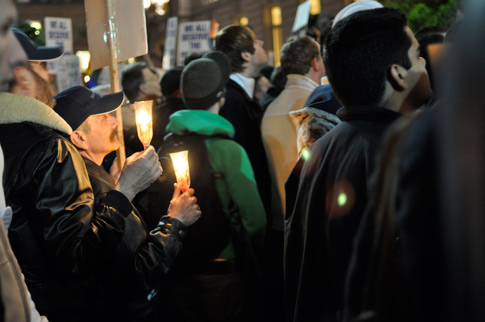
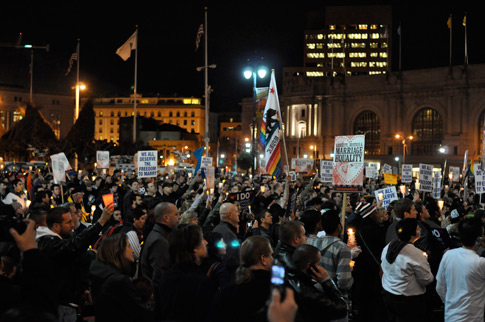
From Wednesday night’s vigil and rally at City Hall, San Francisco
blog CA life without a car other personal
Ok- obviously not art related at all, but I’ve looked all over the internet and couldn’t find anything helpful so I thought it might be useful information to put out there.
As some of you know, we are using the car crash as a cue and trying out life without owning a car. Unfortunately, we are not people who don’t need a car at all and so we have been using City Car Share as well as renting cars about 3 days a month. We’re also renting a car for 5 weeks to drive to and around Utah.
We also just learned a couple things about renting a car in California:
1. It’s illegal to drive a car without liability insurance
2. Car rental companies here do not include any state-required liability insurance into the base price of their rental cars. Apparently, California, from what I have read, is the only state where this does not happen. So, if you live in another state and have been buying liability insurance through your rental company, you should know that what you are buying replaces and adds on to what is already included in your rate. I would still check with your specific company to find out if this is true, but it seems to be. We use our credit card for our collision insurance. Again, you still need to check with your credit card to find out what your terms are because they vary a lot. We use Amex Blue (which we specifically got for it’s good rental car coverage)
So- 5 weeks of buying insurance at $13 a day is a lot. What other options are out there, you ask? Well, there are Named Non-Owner policies. These policies are for people who drive either rentals or other people’s cars. It is an insurance plan for the person, not the car. However, you can only do this for cars that you do not own.
blog neat projects personal we make stuff
We’ve all had the moment of having an argument and going to the internet to prove (or disprove) your theory. Oliver’s made a quick solution for every situation or discussion. Argument over. The internet has proved your point.
just enter your name and then .istotallyright.com
Here’s an example: http://eleanor.istotallyright.com
Want your full name? Just use a period for every space.
genius
*******UPDATE**********
If it seemed at all confusing before, with periods and no periods, Oliver’s made it easier. Now just go to http://istotallyright.com/ and there is a little form to fill out and it will make you the link as you fill in the form. Click the link and you are good to go.
art and politics arts funding blog TPG8
The NEA announced yesterday the details for how it plans on distributing the $50 million dollars as part of the Recovery Act. Rumors that 60% of the money would be spent on individual projects are simply not true. That 60% will be competitively awarded to nonprofit agencies throughout the country for salary support for positions in jeopardy or for which the positions have already been eliminated, and/or for fees for artists and/or contract personnel.
The big stipulation is that these non-profits have to have received an NEA grant within the past 4 years. So I guess it’s only for big, well established places. Too bad for all you little guys. Also, the deadline for applications is April 2nd.
It is possible that some little guys might have luck through re-granting through some of the bigger agencies or through their state agencies. Hopefully the state agencies are very much on watch for this money because their deadline is March 13th.
You can view the details here.
Sidenote: I am a blogging machine today!
artist interviews blog others lives reblog
From Freize:
Over the last decades, the art world has become more and more professionalized. For an online-only survey, frieze asked 16 curators, writers and artists how they thought the languages, codes, education and business methods resulting from this process are affecting creative freedom. Is the art world too professionalized – or not enough?
The Box Game is the traveling stage of a larger artwork called ‘What’s in the Box’. In the month of March a black box will be taken to various locations throughout the United States and Canada by Lukas Geronimas and David Horvitz. At each location they will set up a game that asks people what they think is in the box.
The votes/guesses will determine what is actually in the box and the result will be an exhibition of the box and the guesses.
They will be in San Francisco on March 19th at Clayton Space.
Or, check here to find out when they’ll be near you.
art and politics arts funding blog events TPG8
How apropos!
We might consider going to this conference in light of the really cheap airfare prices right now (we just got tickets from SFO to IAD for $230 RT!) and the reasonable price tag of the conference if we weren’t going to be in Utah. (We are spending one month there for those of you who don’t know and working from there but also exploring. It’s gonna be great.)
But maybe some of you would like to go? It will be a good chance to connect with people trying to organize and pursue more sustainable funding for the arts in this country. You can also lunch with your state leader for the lobbying group Americans for the Arts and possibly start some conversations about what can be done on a more local level.
Get info here: 2009 Arts Advocacy Days
There’s also a Facebook page
art and politics arts funding blog news TPG8
“Arts organizations generate $166.2 billion in economic activity, support 5.7 million jobs, and return nearly $30 billion in revenue to the government each year, according to a 2007 study by The Americans for the Arts.”
With the arts and music among the many industries being hit hard in economic downturn, U.S. Rep. George Miller (D-CA), chairman of the House Education and Labor Committee, recently announced plans to hold a series of hearings this Spring to examine how the arts benefit the nation’s economy and schools – and what can be done to improve support for the arts and music fields. Continue reading here >>
thanks lori
art and politics arts funding bay area blog events news State of the Arts TPG artists TPG8
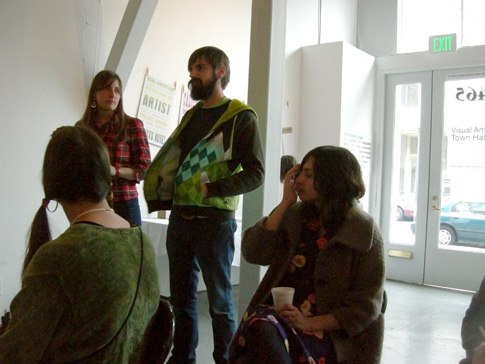 Oliver and I thank everyone for coming, introduce ourselves, the State of the Arts project, and Joseph
Oliver and I thank everyone for coming, introduce ourselves, the State of the Arts project, and Joseph
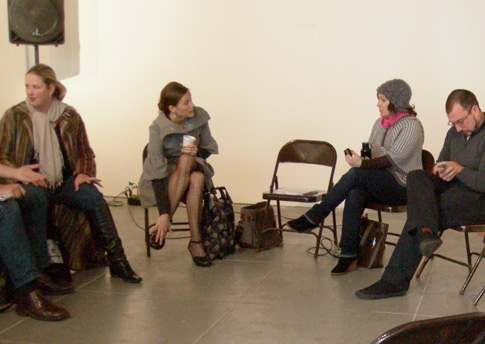 The first panel settles in (L-R: David Huff’s legs (Pro Arts), Christian Frock (Invisible Venue), Svea Lin Vezzone (Swarm Gallery), Kerri Johnson (Blank Space), Mike Bianco (Queens Nails Projects)
The first panel settles in (L-R: David Huff’s legs (Pro Arts), Christian Frock (Invisible Venue), Svea Lin Vezzone (Swarm Gallery), Kerri Johnson (Blank Space), Mike Bianco (Queens Nails Projects)
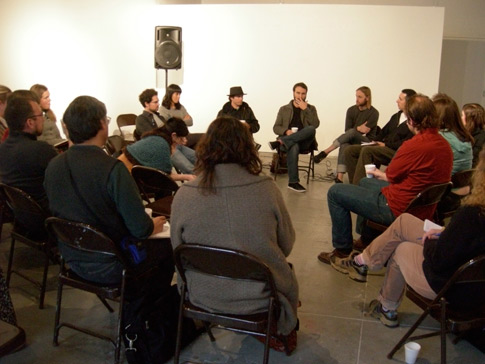 The Artist Respondents move front and center
The Artist Respondents move front and center
The goal of the day was to get a bunch of people talking about issues like arts funding, government and the arts, the stimulus, the economy and what that means for artists, and interesting ways that all these areas may interact. This we accomplished. It is incredibly hard to get a bunch of artists and arts activists who already have an incredibly full work load together and come up with some immediate solutions to any problems, so we didn’t leave the meeting with a clear course of action, but I think that is ok. We’re still really early on, and just hearing out different ideas and perspectives is always fruitful.
I came away with a couple of things in particular though:
1. If artists want more money from government, they have to show up to meetings and prove themselves as a constituency and fight for what they want. They could team up with real estate brokers who know how artists turn areas from bad neighborhoods to desirable ones. They can fight for money in all aspects of government. Someone suggested that every single government project could have some sort of artistic element to it. Even if the budgets for this type of work are small, if these jobs are given only to Oakland (or whichever city you live in) artists, the impact could add up. Mike Bianco spoke about the possibility of starting a union. If a union charged some dues, maybe each locality could hire a lobbyist.
2. The stimulus for the NEA, in comparison to a lot of things, is still very small. Lori Zook, from the Oakland Cultural Arts and Marketing Division, suggested that we look not just to the NEA to get our hands on some stimulus money, but also through Education programs and Community Development Programs. She said there are billions of dollars being funneled into those programs. Now, this assumes that you’d have to fit your art into one of those categories, which is not always the easiest things to do. I was talking to my sister about grants and writing for them in general. Grant writers are incredibly adept at not necessarily fibbing about their projects, but just using the language and framework that the granters want to see. Perhaps we need to become creative in thinking of the ways that our work could be framed.
I was just talking to Joseph and he thinks this idea is a little bogus, as art should be funded because it is art and we and others should see the value in doing just that. I believe that, but it seems clear in this country that many policy makers do not believe that. So I’m ending at one of the very first topics/quandries of the discussion: how to make people understand, believe in, and fund art for its simple value as cultural capital.
art and politics art market blog others lives TPG8
An artist can have a stable life and still make good art.
I was watching the Barbara Walters interviews after the Oscars last night and she was giving Anne Hathaway a hard time or just kept talking about how her parents were still together, how she had a loving family, and then saying things like, “it doesn’t seem like the right drama for an actor…where’s the angst, where’s the pain?” Hathaway feels the need then to sortof defend her luck, saying that there were certainly bad things that were in her life too…. that she isn’t just a good girl… that she is really “debaucherous” sometimes.
Oliver and I have had this discussion many a time about how there is this huge cultural stigma, even within artist communities, that says you must suffer in order to make good work. I just don’t think it is true. And somebody’s got to start saying it.
Last week I was watching a video from the group W.A.G.E. (Working Artists and the Greater Economy) when they took part in the Democracy in America show put on by Creative Time last fall. The second speaker, K8 Hardy, addressed this idea. She pointed out that the collectors in the art market like that artists are poor, and how this feeds into this whole system. “They want to keep us on the edge because they stupidly think that it makes the work more interesting…. They want us to die poor. That would make their collection more valuable… They romanticize our poverty and outsider status from some misinformed idea or opinion that it makes an artist better to suffer.”
Democracy in America: W.A.G.E. from Creative Time on Vimeo.
So let’s start talking about it. Let’s try to banish this stereotype. Sure, some art is good and comes from suffering. But that does not mean that it is the only way that good art comes about.
art and politics arts funding blog reblog TPG8
When it comes to funding for state arts agencies, California remains not-so-proudly ensconced in its customary slot — dead last — according to a report from the National Assembly of State Arts Agencies.
art and politics arts funding blog good things news TPG8
The $50 million for the NEA to distribute was first passed in the House bill, then removed in the Senate bill, and finally brought back in the bill passed by all of Congress. Almost 100000 letters flooded into congress giving support to this tiny portion of the overall stimulus package.
As Americans for the Arts president Robert Lynch writes,
The nation’s 100,000 nonprofit arts organizations and their audiences generate $166.2 billion annually in U.S. economic activity. They support 5.7 million jobs and provide nearly $30 billion in government revenue. This economic stimulus will minimize the concern that ten percent of arts groups could close this year and helps save thousands of arts workers from losing their jobs.
Hotly contested, called “pork,” “non-stimulative,” and “wasteful” by many republicans led by Sen. Tom Coburn (Oklahoma), Lynch’s statements (see audio recording below) bring into focus the true economic benefits of the arts in this country. This will be a big boon for the NEA and new arts projects. 40% of the money will be dispersed to existing state and regional arts organiztions and agencies and the other 60% will go towards funding new arts projects. (!)
Robert Lynch presents the importance of the Arts to Congress
art and politics art market blog TPG8
via NPR:
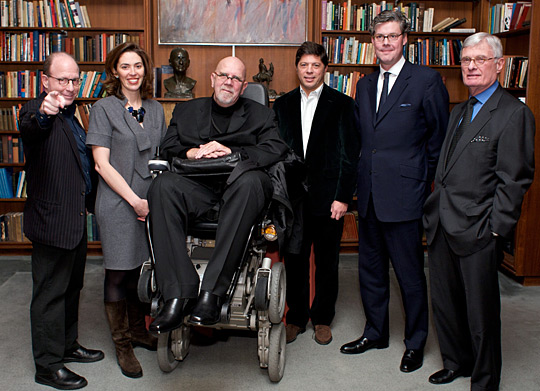 Panelists for the Feb. 3 debate included (from left) Jerry Saltz, Amy Cappellazzo, Chuck Close and Adam Lindemann. Longview Photography
Panelists for the Feb. 3 debate included (from left) Jerry Saltz, Amy Cappellazzo, Chuck Close and Adam Lindemann. Longview Photography
art and craft artist multiples blog neat projects subscription art TPG artists
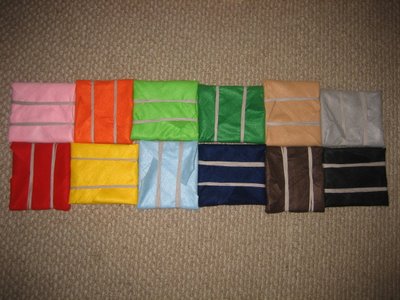
Xiu Xiu‘s Jamie Stewart (a frequent collaborator of TPG9 artist David Horvitz) is selling subscriptions of past ambient, experimental, and minimalist works. For $100 Stewart will send you one CD per month for a year. The edition is 50 so they’ll probably go fast.
thanks andy
art and politics bay area blog events news State of the Arts TPG8
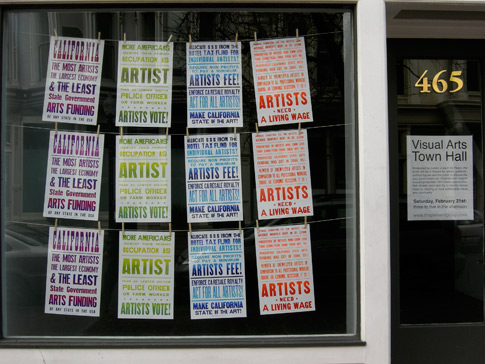
Building on the discussion that began with our eighth issue, “State of the Arts“, we’ll be hosting a Visual Arts Town Hall Meeting in Old Oakland Saturday February 21st from 3-5. Moderated by curator Joseph del Pesco, the meeting will be a chance for artists, gallerists, political figures and the public to discuss the way government can influence and support local art production. We’ll share opportunities that already exist and try to identify simple steps to creating a more sustainable visual arts community.
Participants will include: David Huff (Program Coordinator/Curator Pro Arts), V Smoothe (“A Better Oakland” blog Editor ), Mike Bianco (Queens Nails Projects), Christian L. Frock (Invisible Venue), Kerri Johnson (Blankspace Gallery) Svea Lin Vezzone (Swarm Gallery) and artists: Amy Balkin, Steven Barich (Artopic.org), Helena Keeffe, Aaron Gach, Chris Sollars, David Stein
Visual Arts Town Hall
465 Ninth St. Oakland, CA 94607
February 21st: 3-5 pm
1st hour: moderated panel of gallerists, arts administrators, and politicos
coffee and snack break
2nd hour: artists from the State of the Arts project take the “stage” and respond to the panel and audience questions and comments
This event is sponsored in part by PSAI Old Oakland Associates and Southern Exposure
benefits blog making of subscription art
In the spirit of transparency we’ve decided to show you where all those subscribers’ dues go. Below is the financial breakdown for TPG in 2008. A few things we noticed:.
Compare that to the traditional gallery model where an artist must recoup his or her production costs and profits through their cut of works that may or may not sell. Through the subscription model artists shoulder less risk and art supporters funds are used more efficiently.
Lego Hello World
I wish all my printers were made of legos.
LIFE photo archive hosted by Google
Images from Life Magazine going back to 1860′s, hosted by Google
Coming Face To Face With The President
Well crafted story about an under-heard point of view.
In California, Pot Is Now an Art Patron
A new funding source for the arts – reaping big rewards and funding many projects. It’s pot.
Notes on Portraiture in the Facebook Age
Celebrity Book Club: A List to End All Lists
Because, well, it’s sortof awesome.
Are "Artists' Statements" Really Necessary?
The pros and cons about that nemesis for most artists.
This to That
You tell it what you’ve got and it’ll tell you what to glue them together with.
Work of art: Online store for buyers, sellers
Not the TV show! Kelly Lynn Jones from Little Paper Planes is interviewed on her project, gives us a cheat sheet to local affordable art resources.